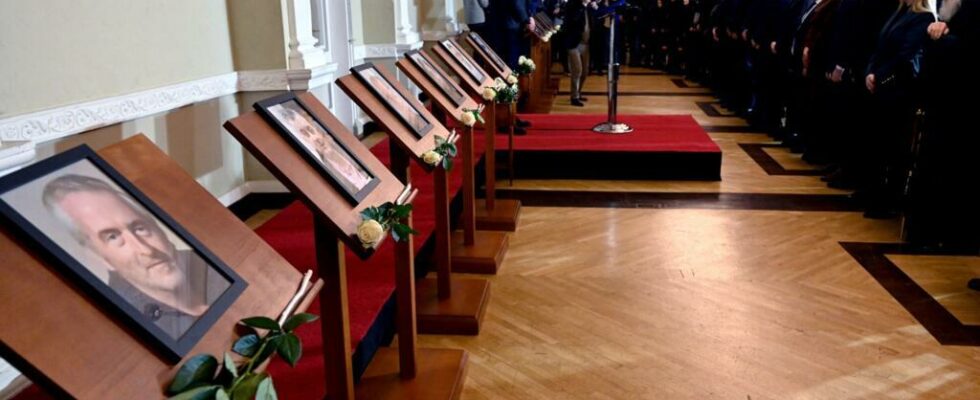After the mass killing on New Year’s Day, Montenegro hesitates between mourning, anger and revolt against the inertia of the authorities. The small Balkan country is one of those in the world where individuals own the most firearms.
5 mins
Wednesday January 1, in the afternoon, after a trivial drunken argument, a 45-year-old man opened fire on other consumers in a cafe in Cetinje, before fleeing, shooting again at passers-by, then commit suicide. Toll: thirteen dead. THE shock is all the greater for the small town of 12,000 inhabitants, the former royal capital of Montenegro, the historical and cultural heart of the small country, that another similar killing had already occurred there in August 2022. The toll was then eleven dead.
The phenomenon of “indiscriminate” shootings was then almost unknown in the Balkans. Even after the wars that ravaged the region in the 1990s, there were only suicides of veterans, quite often also domestic murders, and never mass killings. “For us, the phenomenon only existed in the United States or in television series”says a resident of Cetinje. Yet guns are omnipresent: not a wedding, not a political meeting or an election night without bursts of joy fired into the air. And without ever causing any casualties. In Cetinje, a bastion of Montenegrin patriotism, everyone prides themselves on knowing how to “control weapons”, as well as knowing how to manage alcohol, even in the event of a heated discussion.
Among the most armed countries in the world
A little more than 100,000 firearms are legally owned by 70,000 individuals in this country of 620,000 inhabitants, around thirty thousand of whom practice hunting or sport shooting. However, a study carried out in 2008 by the NGO Small Arms Survey reveals that at least 250,000 people own weapons, or 40% of the total population, all sexes and ages combined. This makes Montenegro the third most armed country in the world, tied with neighboring Serbia, surpassed only by Yemen and the United States.
Many weapons are passed down from father to son, as a token of virility and a symbol of family honor. The conflicts of the 20th century enriched the arsenal, particularly those of the 1990s. During the time of Yugoslavia, the “popular defense” system allowed volunteers to keep their weapons at home, as is the practice in Switzerland, but most of these weapons have escaped all control. The Balkans, major producers of small arms found on all the battlefields of the planet – from Sudan to Ukraine, via Yemen and Libya – have also become a crossroads for arms trafficking , particularly aimed at criminal networks in Western Europe.
After the first killing in August 2022 in Cetinje, the phenomenon seems to have spread like an “epidemic” across the region. In August 2024, three people were killed in a school in Bosnia-Herzegovina, six others the previous month in a retirement home in Croatia, but above all it was the two successive shootings that Serbia experienced in May 2023, first in a school in Belgrade (nine dead) then, two days later, in the small town of Mladenovac (eight dead), which shocked public opinion, sparking an immense wave of CONTESTATION. Under the slogan “Serbia against violence”, the movement shook the authoritarian regime of President Vučićaccused of promoting a “culture of violence”.
An anger that does not subside
Montenegrin Prime Minister Milojko Spajić promises a drastic revision of the law on the possession of weapons, but this reaction seems too weak given the scale of the anger. On Friday afternoon, hundreds of people gathered in front of government headquarters, demanding the resignation of all security officials. When police officers deployed in front of the building, the crowd whistled at them and shouted: “where were you on January 1st?” » Indeed, at the time of the tragedy, according to daily revelations Vijestionly nine police officers were on duty to ensure security throughout the very vast territory of the municipality of Cetinje which, in addition to the small town, includes numerous villages and mountain areas.
At the call of a student collective, demonstrations were called for Sunday afternoon in Cetinje then in the early evening in front of the police headquarters in Podgorica, the administrative capital of the country. This is where this collective will make its demands known. In the spontaneous gatherings which are multiplying in Montenegro, a slogan is already emerging: “your hands are bloody”the same as that put forward in Serbia since the collapse of the awning of Novi Sad stationon November 1, which cost the lives of fifteen people.
Since then, more than 60 faculties are still occupied throughout Serbia, the students, supported by many citizens, demanding “ justice and truth ”, as well as the resignation of the government. Every day, they block the main intersections of the country by observing fifteen minutes of silence in honor of the victims of Novi Sad but, since Friday, 29 minutes of silence have been respected, in tribute to the victims of Novi Sad, of Cetinje and those of another crime committed in the small town of Arilje. In unprecedented symbolism, demonstrators silently united the Serbian and Montenegrin flags in front of the Rectorate of Belgrade on Friday.
In Serbia, the movement of anger continues to reach new social categories, such as farmers who oppose lithium mining projects and brandish the same symbol of a bloody palm on their tractors as the students in their lecture halls. busy. In Montenegro, where this symbol is used, the wave of protest is only just beginning and in other countries in the region, notably in Croatia, students are also mobilizing in solidarity. Will an unprecedented “convergence of struggles” set the Balkans ablaze?
